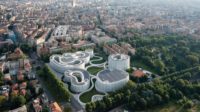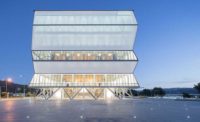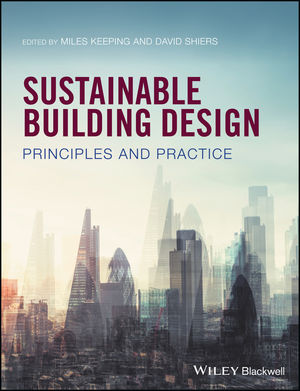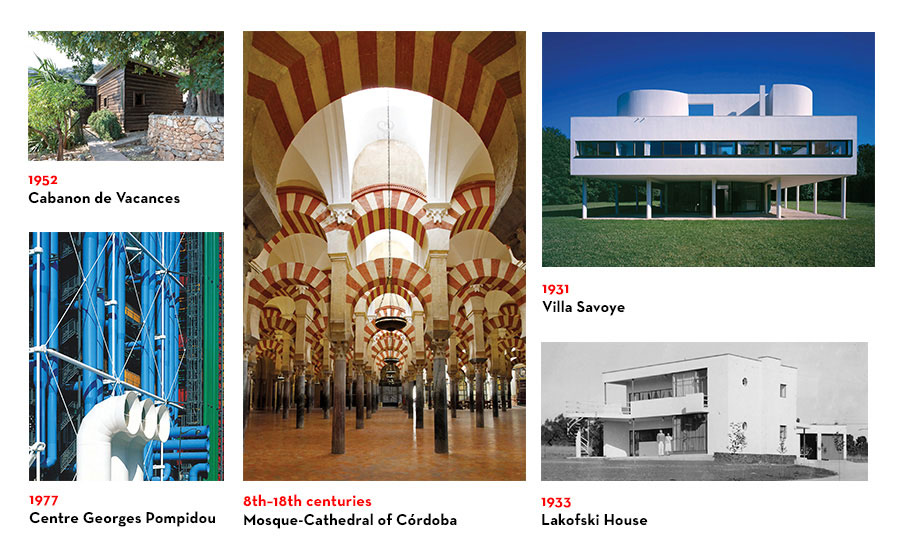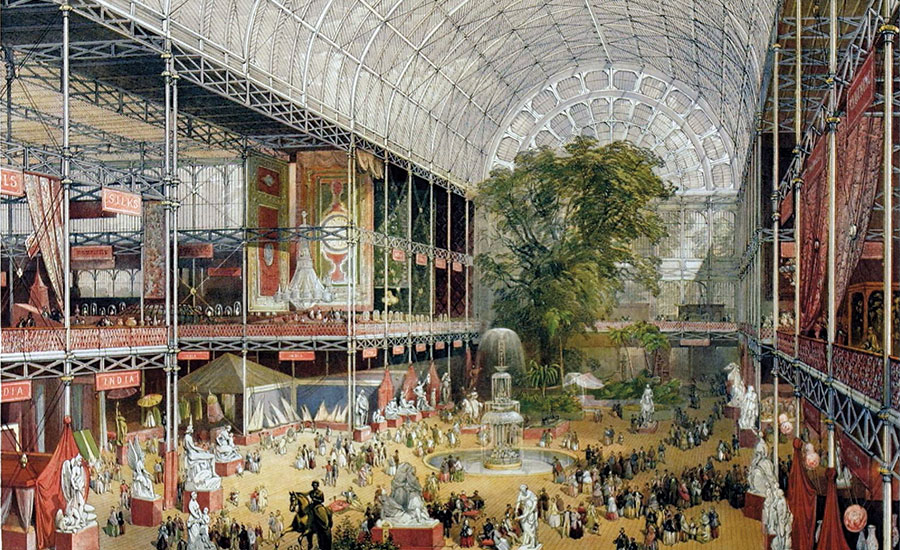Celebrating 125 Years: The Past
My Favorite Building
RECORD asked a dozen leading architects to tell us which single building had the biggest impact on their thinking and design. Some of their answers may surprise you.


Norman Foster: Crystal Palace | 1851 | Joseph Paxton | London
The period that I find most inspiring is the 19th century. We see its can-do mentality in the work of many people of the time, whether they were tunneling under rivers or throwing bridges across ravines and gorges. And we see it in the example of Joseph Bazalgette, who built the London sewer network. He used the project as an opportunity to create underground public transportation, and managed to transform infrastructure into a work of great civic beauty with the construction of the Thames embankments.
If I were to sum up that spirit with one building, it’s Joseph Paxton’s Crystal Palace for the Great Exhibition of 1851—which was not created by an architect, but a gardener. It was an extraordinary act of competence that required the ability to create a new industry for a building, which had to be designed and constructed almost overnight, at an epic scale, and with what I suspect would have been breathtaking beauty. It is the building I would most like to have visited.
Such buildings as the Crystal Palace had a romance that was absolutely contagious and enthralled the public. Although industrialization had some appalling social consequences, these works show an incredible optimism. Today, those of us who are privileged to engage in projects on that scale in other parts of the world still find that belief in the future, a belief that has not become jaded and cynical. What I’m invoking in the heroic works of the 19th century is really that attitude of mind.
Photo courtesy Victoria and Albert Museum

Thom Mayne: Centre Georges Pompidou | 1977 | Studio Piano & Rogers | Paris
I went to USC in the late ’60s—when the school was anti-history. I came away with very little knowledge of even the major characters—Mies, Corbusier. So I was largely self-taught. After I began my practice, I went through a Kahn phase, a Rudolph phase. Remember, I was still a kid. I became fascinated by James Stirling, and I went to England and saw all his work. My list of influences was enormous. That being said, if I had to name a single building, it would be the Centre Pompidou. It had this incredible influence on me, in terms of the intensity of the research that went into it. I had two friends from UCLA who were working on the building, and I visited them at the office. There were dozens of blue-foam models of the gerberettes [custom cast-steel elements]. I was completely bowled over by the seriousness of the investigation. I didn’t go home and start making buildings that look like the Pompidou. That’s not my architecture. I was interested in its aspirations, in its ambition—the notion of challenging the Louvre, the museum as supermarket. It was a completely new model, architecture shaping how we understand culture. I had an exhibition there in 2006. Designing the show, we put everything on a glass floor. We didn’t touch the walls. We were reverential.
Photo © Denancé Michel/courtesy Renzo Piano Building Workshop

Richard Meier: Fallingwater | 1939 | Frank Lloyd Wright | Bear Run, Pennsylvania
I had the pleasure of spending the night at Fallingwater, as a guest of Edgar Kaufmann Jr. It must have been the early ’60s. But I have the experience in my head as though it was yesterday. It starts when you drive up—seeing it, not seeing it, then seeing it again. The whole approach is brilliant. There’s not a thing that’s accidental, that’s not a part of the plan. It’s total. Later, when you walk the site and see how the house is perched on this rock over the waterfall, it’s truly magnificent. I had a bedroom that was maybe 7 feet by 10 feet. It was intimate—but so is the whole house. From photos, you think it’s a big building. It’s not. The living-dining room makes people come together. But, of course, that room explodes onto the terrace over the waterfall—part of an unbelievable series of spatial experiences. It’s like the Guggenheim Museum: it’s amazing from the outside, but the interior space is even more amazing. I haven’t been there since, but it’s still with me. If I could achieve something like that, I’d be very happy.
Photo courtesy Library of Congress

Denise Scott Brown + Robert Venturi:
Villa Savoye | 1931 | Le Corbusier | Poissy
France, Lakofski House | 1933 | Norman Hanson | Johannesburg
If you ask Bob, “What is your favorite building?” he will say the Hagia Sophia. If you ask him, “What is your favorite Modern building?” he will say the Villa Savoye.
For me? I remember, at the age of 2, standing with my parents on an empty lot looking at blueprints. We had moved from Zambia to South Africa and were building a house. It was by Norman Hanson, who had made contact with Le Corbusier and then returned to do fantastic International Style houses in Johannesburg. We built that house and I lived there until I was 12. For that reason, the memories other kids have about attics and creaky staircases I have about flat roofs and lally columns. I remember a porthole window, watching the light come through it, and the circle of sun moving across the room as I lay on my parents’ bed in the late afternoon. I harbored a love of early Modernism then, and I am still an early Modernist—and, by the way, so is Bob. Bob is the most dour functionalist I’ve ever come across—even more than me. We really just added one more function—communication through decoration—to the functions of early Modernist buildings.
Villa Savoye (top) photo: Paul Kozlowski/© Fondation Le Corbusier/Artists Rights Society
Lakofski House (bottom) photo courtesy Denise Scott Brown

Frank Gehry: Shosoin Treasure House | 750s | Nara, Japan
Going back to my absolute roots in architecture, I would say the Shosoin Treasure House in Nara in Japan. When I was starting out in architecture in L.A., the Japanese influence was strong. I first saw the Shosoin repository in person when I got the Pritzker Prize [in 1989], at the Todai-ji Temple next door, but I had known it for a long time. It’s from the 750s. The Ise Shrine, Katsura Palace, Kiyomizu-dera temple were all required study, like the great buildings of past western culture that we revere. The Kiyomizu is on a hilltop—it’s really a hard climb up. I’ve been there twice. The substructure that anchors the temple to the hillside is a major architectural accomplishment. The Shosoin is a warehouse—it’s much simpler. It’s in the log cabin style called azekura and shows the elegance and simplicity of Japanese building. Mesmerizing for a beginner.
Photo © Wikimedia user Moja/Creative Commons

Rafael Moneo: Mosque-Cathedral of Córdoba | 8th–18th centuries | Córdoba, Spa
The Córdoba Mosque, which I first visited as a student, has been a continuous lesson to me for more than half a century. The building is a theological experience. The Islamic sense of an indecipherable god is present there. The essence of architectural space is expressed in that forest of columns, many of which were Roman. That’s not about recycling—it’s about the unfolding of history. When the mosque was enlarged, the formal rules that created the building allowed it to grow without losing its essence. Of course, in the 16th century, there was a very radical intervention—an entire cathedral was placed inside the mosque! But even that didn’t destroy it—the combination of the Islamic and the late Gothic only adds to the sense of history. A building that can accept something so different is a marvel. I think you are looking at one of the most successful buildings in all of architectural history. And there is no one architect associated with it. It’s about architecture, not about a single architect. That idea has stayed with me throughout my entire career.
Photo © Pixabay user Salao228/Creative Commons

Fumihiko Maki: Municipal Orphanage | 1960 | Aldo van Eyck | Amsterdam
For me, the building that inspired the most fundamental thoughts on architectural issues is the Municipal Orphanage in Amsterdam, by Aldo Van Eyck, completed in 1960. The first reason is that the building clearly shows how to construct a dynamic whole out of a thoughtful composition of generic elements—in this case, a spatial unit in and around which children live and play. Van Eyck says this idea was inspired by villages in Africa, but it could be any village, as Bernard Rudofsky illustrated in Architecture Without Architects, some years ago [1964]. Van Eyck has beautifully realized this concept using a modern architectural vocabulary. The second reason is that the building clearly shows the importance of guiding sight lines in the organization of space. Humans tend to act after first seeing; thinking and feeling come later. I have not seen such a beautiful analysis of the relationship between sight line and space before or since. These two issues are eternal ones, and the Orphanage is a skillful and didactic example of how modern space is driven by them. It continues to inspire my work to this day.
Photo © Gerard Dukker/courtesy State Service for Cultural Heritage (Netherlands)

Jacques Herzog
Tough question. I don’t want to sound arrogant, but I have never been influenced by a specific building. And I think Pierre would give you pretty much the same answer. We look closely at many buildings, and we see a lot of beauty in many of them. We’ve never really admired one building specifically. Last year, I wrote a text about my visit to the Farnsworth House. I was ready to admire it for its beauty, but I discovered many things that made no sense. The truth is, it’s not as great as everybody thinks. I wrote a very critical text. Still, I learned from the house, because it activated my perception. Active perception is what you create out of what you see. It makes you become conscious and critical. Perception therefore also has a political and erotic side. Your perception is more important than the object being perceived—more important than any specific building.

Renzo Piano: Dome of the Florence Cathedral | 1436 | Filippo Brunelleschi | Florence
I’m in trouble, because so many buildings have influenced me. When I see a building for the first time, I don’t focus on what I don’t like; I focus on what I do like. So I absorb things from many buildings. But if I have to pick one, it would be Brunelleschi’s Dome of Santa Maria del Fiore, in Florence. I spent two years in Florence as a student, in ’58 and ’59, and I’ve always loved the story of Brunelleschi. This man started not as an artist but as a craftsman, apprenticed to a goldsmith; soon he was making clocks, which meant working with weights, with balance, and with movement. Then he became an architect, designing buildings using the knowledge he acquired making clocks. I’ve been convinced that you might start as a craftsman, then become more of an artist, possibly, but it’s almost impossible to do the opposite. As for the cupola itself, it was very inventive; the lantern at the top acts as the keystone of the dome. It’s a very radical idea. Brunelleschi made a model of the dome, which sat in the piazza. And it stayed there for years—because it took him years to persuade people that it would work. It’s a lesson in stubbornness. It taught me about the art of believing in what you are doing and defending your idea. The dome is beautiful, but so is the story behind it.
Photo © Petar Milosevic/ Creative Commons

Tadao Ando: Chapelle Notre Dame du Haut | 1955 | Le Corbusier | Ronchamp, France
There are many buildings that have remained in my heart and that I still think about from time to time. If I had to choose one from among them, it would have to be Le Corbusier’s Ronchamp Chapel. The great master who laid the foundations for Modernism created the space by truly unleashing his genius late in his career. Here, he paradoxically demonstrated the limitless possibilities of Modern architecture by creating the unrestrained sculptural form of concrete in an apparent rejection of the trajectory of his earlier work. At the same time, he proved, with the almost violent space of rich light, that architecture can be made through the pursuit of light alone. It is a rare work that has, from the moment of its birth, brimmed with the power to last throughout time, like the spaces of classical architecture. I had the opportunity to witness a Mass when I visited the building for the second time, in my 20s. People were praying intently, shoulder to shoulder, under the beautiful yet intense light. To this day, that scene has been an inspiration for me in my pursuit to create architecture as a place for people to gather.
Photo: Paul Kozlowski/© Fondation Le Corbusier/Artists Rights Society

Toyo Ito: Cabanon de Vacances | 1952 | Le Corbusier | Roquebrune-Cap-Martin
I visited the Cabanon de Vacances several years ago for the first time. I was deeply impressed by the fantastic architectural concepts drawn from such a modest cabanon, created by the master of 20th-century architecture in his last years. It is often the case that architects lose their creative energy in their later years. I wish to express my deepest admiration for Corbusier’s affluent architectural creation as he aged. I also admire his powerful works in Chandigarh and Ahmedabad
in India.
Photo: Olivier Martin-Gambier / © Fondation Le Corbusier/Artists Rights Society












Interviews conducted by Fred Bernstein, with Chris Foges and Cathleen McGuigan.

